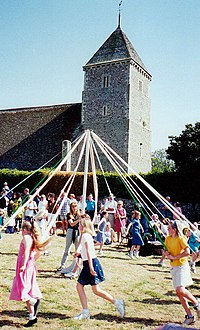
Back يوم مايو Arabic मई दिवस Bihari První máj (svátek zamilovaných) Czech Brauchtum im Mai German Πρωτομαγιά Greek Festividad de los Mayos Spanish روز مه Persian Altjóða arbeiðaradagur Faeroese Fêtes de mai French Lá Bealtaine Irish
| May Day | |
|---|---|
 | |
| Type | Public holiday |
| Significance | European festival of ancient origins marking the beginning of summer |
| Date | 1 May<3 |
May Day is a European festival of ancient origins marking the beginning of summer, usually celebrated on 1 May, around halfway between the Northern Hemisphere's Spring equinox and June solstice.[1][2] Festivities may also be held the night before, known as May Eve. Traditions often include gathering wildflowers and green branches ("bringing in the May"),[3] weaving floral garlands, crowning a May Queen (sometimes with a male companion), and setting up a Maypole, May Tree or May Bush, around which people dance and sing.[4] Bonfires are also a major part of the festival in some regions. Regional varieties and related traditions include Walpurgis Night in central and northern Europe,[1] the Gaelic festival Beltane,[5] the Welsh festival Calan Mai,[5] and May devotions to the Blessed Virgin Mary. It has also been associated with the ancient Roman festival Floralia.[6]
International Workers' Day observed on 1 May is also called "May Day", but the two have different histories.
- ^ a b Melton, J. Gordon (2011). Religious Celebrations. ABC-CLIO. p. 915. ISBN 9781598842050.
- ^ "May Day Celebrations". Historic UK. Retrieved 2 May 2021.
- ^ Wilks, Jon (22 April 2023). "Customs Uncovered: Bringing in the May". Tradfolk. Retrieved 1 May 2024.
- ^ "May Day". Encyclopædia Britannica. The Editors of Encyclopaedia Britannica. Encyclopaedia Britannica, inc. 26 July 2016.
{{cite web}}: CS1 maint: others (link) - ^ a b Hutton, Ronald (1996). Stations of the Sun: A History of the Ritual Year in Britain. Oxford University Press. pp. 218–225. ISBN 978-0-19-820570-8.
- ^ Joshua, Essaka (2016). The Romantics and the May Day Tradition. Routledge. p. 16.
© MMXXIII Rich X Search. We shall prevail. All rights reserved. Rich X Search